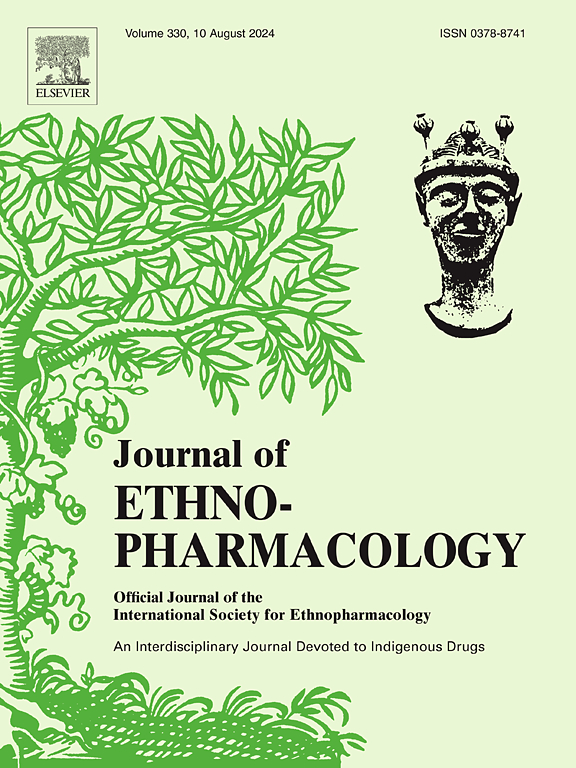Panax notoginseng saponins treat steroid-resistant lupus nephritis by inhibiting macrophage-derived exosome-induced injury in glomerular endothelial cells via the mitochondrial Autophagy-NLRP3 pathway
IF 4.8
2区 医学
Q1 CHEMISTRY, MEDICINAL
引用次数: 0
Abstract
Ethnopharmacological relevance
Microangiopathy represents a critical pathological characteristic of lupus nephritis (LN), with steroid resistance (SR) frequently observed among patients. Panax notoginseng saponins (PNS) has demonstrated potential in mitigating P-glycoprotein (P-gp)-mediated SR and attenuating inflammatory damage in glomerular endothelial cells (GECs) through exosomal pathways, although the precise mechanisms underlying these effects have yet to be fully elucidated.
Aim of the study
This research examines the impact of PNS on microangiopathy in steroid-resistant lupus nephritis (SR LN) and explores its involvement in the mitochondrial autophagy-NLRP3 inflammasome pathway mediated by exosomes.
Materials and methods
Steroid-resistant models were developed using methylprednisolone (MPS) in murine peritoneal macrophages (Mø). Exosomes were characterized, and biochemical markers of lupus nephritis (LN) were evaluated. Renal pathological alterations were analyzed using hematoxylin and eosin (H&E), Masson's trichrome, and periodic acid-Schiff (PAS) staining. Mitochondrial autophagy was assessed through transmission electron microscopy. Apoptosis, mitochondrial membrane potential (MMP), P-glycoprotein (P-gp), Rhodamine-123 (Rh-123), and reactive oxygen species (ROS) were measured using flow cytometry. The expression of MDR1, PINK1/Parkin, and NLRP3 at the protein and gene levels was determined via immunoblotting and real-time PCR.
Results
Exosomes derived from SR Mø increased the expression of MDR1 and P-glycoprotein (P-gp) in GECs, reduced Rhodamine 123 (Rh-123) accumulation, inhibited mitochondrial autophagy, and activated the NLRP3 inflammasome, thereby exacerbating renal inflammation and tissue damage. Conversely, PNS were found to lower the levels of pro-inflammatory cytokines, including interleukin-6 (IL-6), tumor necrosis factor-alpha (TNF-α), interleukin-18 (IL-18), and interleukin-1 beta (IL-1β). PNS also decreased P-gp expression and increased Rh-123 accumulation. Furthermore, PNS downregulated cleaved-Caspase1 while upregulating PINK1, Parkin, Beclin-1, and the ratio of LC3II/LC3I. This dual effect of PNS reversed SR and improved renal inflammation damage.
Conclusion
PNS demonstrated an improvement in renal function and a reduction in histopathological damage, suggesting its potential therapeutic applications for LN.

求助全文
约1分钟内获得全文
求助全文
来源期刊

Journal of ethnopharmacology
医学-全科医学与补充医学
CiteScore
10.30
自引率
5.60%
发文量
967
审稿时长
77 days
期刊介绍:
The Journal of Ethnopharmacology is dedicated to the exchange of information and understandings about people''s use of plants, fungi, animals, microorganisms and minerals and their biological and pharmacological effects based on the principles established through international conventions. Early people confronted with illness and disease, discovered a wealth of useful therapeutic agents in the plant and animal kingdoms. The empirical knowledge of these medicinal substances and their toxic potential was passed on by oral tradition and sometimes recorded in herbals and other texts on materia medica. Many valuable drugs of today (e.g., atropine, ephedrine, tubocurarine, digoxin, reserpine) came into use through the study of indigenous remedies. Chemists continue to use plant-derived drugs (e.g., morphine, taxol, physostigmine, quinidine, emetine) as prototypes in their attempts to develop more effective and less toxic medicinals.
 求助内容:
求助内容: 应助结果提醒方式:
应助结果提醒方式:


